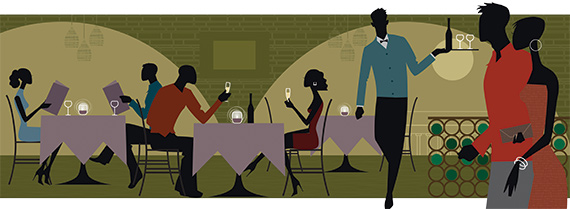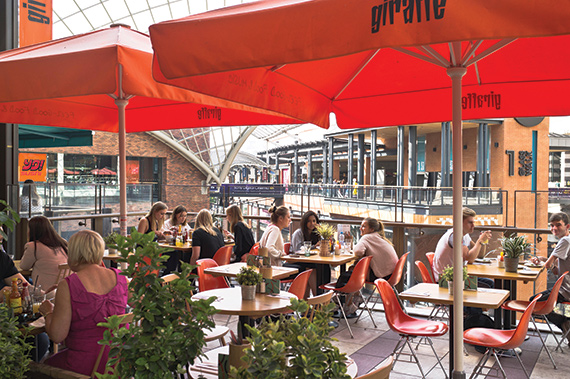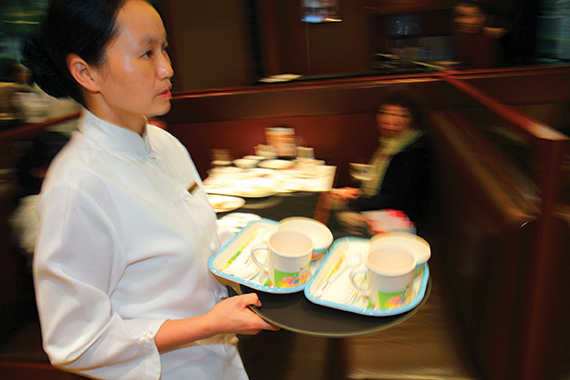At a glance
• Research shows 20% of shopping mall visitors eat there but buy nothing
• Anchor stores are increasingly incorporating food offers in their stores
• Retail parks are bringing in food and beverage offers, as well as gyms
• F&B offers are moving away from the food court to separate retail units

REX/SHUTTERSTOCK
Why do people go to a shopping centre? Probably for the choice or range, possibly for the convenience, maybe for the experience. There are myriad reasons for a trip to the mall (as any teenager in 1990s America could tell you), but primarily you go there to shop. Right?
Well, perhaps not any more. According to a new report by CBRE, which canvassed the views of some 22,000 shopping centre visitors across 22 EMEA countries, a third of visitors have no intention of shopping at all. They go there to eat.
Of those, around four in 10 said that they then went on to shop. But that leaves around 20% of all visitors who go for a bite to eat, and then do not buy a thing from a single traditional retail store.
So, is it time we stopped calling them shopping centres? Is ‘eating centre’ more appropriate? Or are they becoming something else altogether?
The food and drink offer, as well as leisure, has played an increasingly important part in shopping centres over the past five years. And any idea of a stigma attached to eating at the mall is now long gone. According to the same CBRE study, 41% of those surveyed said they actually preferred to eat in shopping centres, compared to just 10% who favoured restaurants and cafés on the high street.
“The key question,” says Max Poole, partner at Holder Mathias, “is whether shopping centre owners are prepared to forfeit the higher profit margins they make from traditional retail units in the short-term to make way for more independent or alternative retailers.”

While over time they may benefit from greater footfall, more dwell time and higher profit margins, in the short-term giving more space over to food and beverage tenants is costly.
But needs must. “Consumers are savvier than ever before, therefore we cannot keep replicating the same retail formats,” says Poole. “We need to design for people and with leisure in mind.”
As a result, more restaurants are being brought in to retail environments. “A lot of anchor stores are also incorporating food offers within their stores to create a more interesting retail experience for the consumer,” says Poole.
At Eldon Square in Newcastle, intu is in the process of putting in 20 restaurants, increasing the space given over to food and beverage (F&B) to 15%.
Capital & Regional will not be drawn on their target for F&B. “It varies, but north of 10% is where it settles,” says James Ryan, executive director, who adds: “But in city centres it could go much higher.”
Across its portfolio British Land is now aiming at 15%, with larger assets perhaps reaching 20% and higher. At Whiteleys in Southampton the proportion is nearer 25%.
At present, only 8% of British Land’s rent roll comes from F&B tenants: three years ago that was just 3%. Meanwhile the number of F&B tenants across the portfolio has increased by 33%. And a study by the company earlier this year showed that people who ate visited 20% more stores and spent 26% more than those who didn’t eat.
“Five years ago shopping parks didn’t have loos and the F&B was 1%,” says Charles Maudsley, head of retail and leisure for British Land. “If you can’t eat and you can’t wee you stay for an hour. When we opened the F&B at Glasgow Fort Park the sales went up by 10% and footfall went up 10%.”
But Maudsley’s statistics are less revolutionary than CBRE’s. “What our research shows is that on average 25% who come, eat,” he says. “But only 5% come just for the food.”
Even so, the idea that anyone would go to a shopping centre just for the food is a major shift from a few years ago.
The same goes for retail parks, says Neil Varnham, Pradera chief executive and former BCSC chair. Pradera has bought 22 retail parks in the past year and is now the biggest retail park owner in the UK. “Across that portfolio we have been bringing in more F&B and gyms – it is the same methodology.”
Rob Williams, head of retail agency and development at Strutt & Parker, believes this is just the beginning. According to his firm’s Property Future research 79% of respondents agreed that, within the next 10 years, F&B operators, as well as leisure, will account for up to 50% of the space within the largest shopping centres.
“The F&B footprint within shopping centres delivered in the past five years has reached between 30% and 35% from around 5% to 10%, which was the norm around the turn of the century,” says Williams.
Another change is where the eateries are located. “There has been a visible shift away from the food court and coffee shop provision,” Williams notes. Now the restaurants are interspersed with the retail units.
But it isn’t just the sheer square footage. British Land is also looking at getting higher quality restaurants in many of its assets.
Perhaps those American teenagers weren’t so Clueless after all. The mall is the place to be, not just to shop.
Out of town and town centre
“Where a shopping centre fits in a town centre it becomes part of that town centre,” says intu chief executive Mike Butterworth. “People may go into a town centre shopping centre for a bite to eat and then leave.”
For out-of-town it is just one part of a much larger experience. “People don’t just go to the Trafford Centre to eat. They go there to shop,” says Butterworth. “Once they are there the catering offer helps to keep them there.”
The same goes for the other non-retail elements of Manchester’s Trafford – the hotels, the climbing walls, the skydiving and the cinemas. The leisure keeps people close to the shops, and in a purchasing mood.
Internationally the shift from pure retail to F&B has been more pronounced. But Butterworth thinks that it will not go much higher than 15% in the UK. “That is a good target for catering and leisure,” he says. “And that means there is still a lot of work that we can do.”
When intu bought Merry Hill in the West Midlands, the ratio “was only about 7%”. That is now being brought up to nearly 15%. “In virtually every scheme that we have got we are looking to improve and increase the food offer,” says Butterworth.
While town centre restaurants tend to be busy at lunch or early evening, in shopping centres they can be buzzing all day. “That has helped to increase the rents,” says Butterworth. “They are coming on a par with retail.”
The additional leisure and the refocus on eating and drinking also has the potential to greatly extend the profitability of the centre by extending its active hours.
Captive audience
As well as helping to drive up footfall and dwell time, restaurants can help retailers in other ways.
One is by providing a captive, receptive audience to whom the retailers can showcase their wares. Sitting down at Leon to satisfy your appetite for a snack may end up stoking your appetite for the shoes in the shop window over the concourse. This, in turn, will gradually transform how retailers manage their displays.
“Historically, retailers had to focus on goods sold per sq ft,” says Holder Mathias’s Max Poole. “But by allocating space to visual and experiential displays, they will stand a better of chance of attracting and retaining customers.”
Just eat
There is no question as to why asset managers and landlords are upping their food offers. But will shops ever play second fiddle to the restaurants?
“For the prime dominant centres that is very unlikely,” says intu chief executive Mike Butterworth. “Shops will always rule. But the ratio is changing radically.”
For smaller assets in vibrant areas, the concept is already being tested, and seems to be working. “There are already a few pure food and beverage areas, especially in London,” says British Land’s Maudsley. Indeed, British Land has created just that in Broadgate Circle, EC2, with a 100,000 sq ft hub of cafés and restaurants.
Poole argues that this will become ever more popular. “We are already seeing this in areas such as Brixton Village and Lewisham Model Market, where there is a growing trend for local food markets, pop-up shops and a mixture of different retailers coming together to form dynamic retail and leisure experiences.”
Look to the East

Food may be an increasingly important component in the UK’s shopping centres, but, compared with other nations, we still have a long way to go.
“In Asia food and dining are frequently a much more significant part of the space and mix,” says Stuart Rough, group chairman at Broadway Malyan, who has worked on shopping centre and mall projects globally, and extensively in Asia. “In China, for example, ratios are frequently double European levels and up at 35-40% of total space.”
In India, where refurbishment and repositioning is the mainstay of the market, with little new build, the brief is to add more food and introduce more quality, says Rough.
“Owners are using food as a key differentiator in a competitive market and so designing great dining spaces and having a quality food offer is making the difference between centres that are busy and succeeding and those that are struggling,” he says.
In the UK the food offer is seen as a vital way of attracting customers and keeping them for longer, but in Asia it is almost becoming the main event.
Along with the increase in the proportion of space given over to F&B, China does something else a little differently. “China in particular is very different in terms of the quality of dining format and experience,” says Rough.
In the UK, the ‘classier’ restaurants tend to be outside the malls, with the food and drink offer inside tending to be more functional, with the odd exception such as Westfield’s champagne bar (see pxx). “In China, we are seeing the very highest level of dining within retail centres. The offer and range is terrific,” says Rough. Partly that has something to do with climate and air-conditioning, but mostly it is due to a shift in expectations.
He adds: “That’s a key difference and I would expect to see some of that thinking coming across more to the UK and Europe too.”
Shopping centre of leisure centre?
While not every out-of-town mall can equal Bluewater in Kent or the Trafford Centre in Manchester, with its 70 restaurants alongside skydiving centre and hotels, more is expected.
“We envisage that this will evolve even more to include additional leisure amenities such as theatres, aquariums and health spas,” says Rob Williams.
Max Poole also argues that it should not stop with restaurants. More retail space should be sacrificed to provide improved public realm, parks and spas. “If you achieve the right balance of retail and leisure, it will lead to increased catchment and footfall.”
Mike Butterworth is more circumspect. “We try different things. Medical centres looked like a good idea. But I cannot say any of them have been truly successful.”
But he acknowledges that, in the pursuit of “experience and convenience”, the sky is the limit. “Heaven knows where this could go in the future.”











